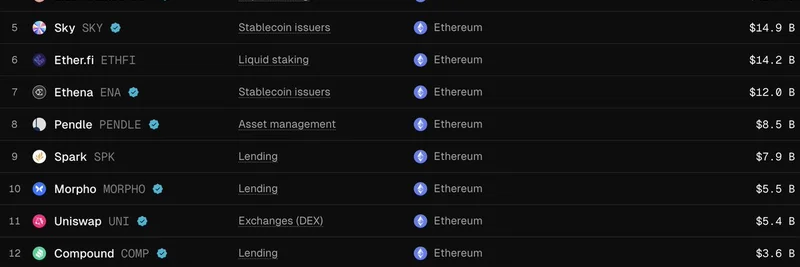In the ever-evolving world of blockchain, Ethereum continues to stand out as the powerhouse for decentralized finance (DeFi). A recent tweet from Token Terminal @tokenterminal perfectly captures this with the statement: "a chain is only as good as the businesses it hosts—study the businesses." Accompanying this insight is a revealing chart showcasing the top projects on Ethereum ranked by Total Value Locked (TVL), a key metric that indicates the amount of assets deposited into these protocols.
Understanding TVL and Its Importance for Meme Tokens
TVL, or Total Value Locked, is essentially the total value of cryptocurrencies locked in a DeFi protocol's smart contracts. It's a strong indicator of a project's popularity, trust, and utility. For meme token enthusiasts, high TVL in foundational DeFi projects means better liquidity, more trading options, and enhanced opportunities for yield farming or leveraging positions— all of which can amplify the viral potential of meme coins.
Ethereum's dominance here is clear: every project in the top 17 is built on its network, underscoring why it's the go-to chain for launching and trading meme tokens like PEPE or DOGE-inspired variants.
Breaking Down the Top Projects
Let's dive into the standout projects from the chart, grouped by their market sectors, and see how they intersect with the meme token space.
Stablecoin Issuers: The Backbone of Trading Pairs
- Tether (USDT): Leading with $82.3B in TVL, Tether provides the stable USD-pegged asset that's crucial for meme token trading pairs on exchanges like Uniswap.
- Circle (USDC): At $44.4B, this regulated stablecoin offers reliability for users hedging against meme volatility.
- Sky (formerly MakerDAO's DAI ecosystem): $14.9B TVL, enabling collateralized stablecoins that meme traders use for decentralized borrowing.
- Ethena (ENA): $12.0B, a synthetic stablecoin project that's gaining traction for its yield-bearing USDe, which savvy meme investors leverage for extra returns.
Stablecoins are vital for meme tokens because they provide the liquidity pools needed for low-slippage trades, especially during hype cycles.
Lending Protocols: Leveraging Meme Gains
Lending platforms dominate the list, allowing users to borrow against their holdings or lend for interest—perfect for meme token strategies like going long on a hot coin.
- Aave (AAVE): $56.7B TVL, the king of DeFi lending where meme holders can collateralize assets for loans.
- Spark (SPK): $7.9B, focusing on efficient lending markets.
- Morpho (MORPHO): $5.5B, an optimized lending protocol that's popular for its peer-to-peer matching.
- Uniswap (UNI): While primarily a DEX at $5.4B, it integrates lending-like features through liquidity provision.
- Compound (COMP): $3.6B, a veteran in algorithmic money markets.
- Maple Finance (SYRUP): $3.4B, specializing in undercollateralized lending for institutions, indirectly supporting meme ecosystems.
- Fluid (FLUID): $2.8B, another lending innovator.
Meme token traders often use these to borrow stablecoins against their volatile holdings, amplifying gains (or losses) during pumps.
Liquid Staking: Unlocking ETH for Meme Plays
Liquid staking lets users stake ETH while keeping it liquid via derivatives like stETH, which can then be used in meme token liquidity pools.
- Lido Finance (LDO): $42.4B TVL, the largest liquid staking provider.
- Ether.fi (ETHFI): $14.2B, offering restaking options for higher yields.
- Rocket Pool (RPL): $3.2B, a decentralized staking alternative.
These protocols free up capital for meme investments without sacrificing staking rewards, making Ethereum more attractive for meme launches.
Other Key Sectors
- Pendle (PENDLE): $8.5B in asset management, allowing users to trade tokenized yields— a sophisticated tool for meme yield farmers.
- Curve (CRV): $2.6B as a DEX optimized for stablecoin swaps, often used in meme token arbitrage.
- Securitize: $2.2B in infrastructure, tokenizing real-world assets that could bridge traditional finance with meme culture.
Why This Matters for Meme Token Investors
Ethereum's staggering collective TVL—over $300B from these projects alone—creates a fertile ground for meme tokens. With robust infrastructure for trading, lending, and staking, meme projects can thrive on low fees (via L2s) and high liquidity. As Token Terminal highlights, studying these businesses reveals Ethereum's unshakeable position, even as competitors like Solana gain meme traction.
For blockchain practitioners diving into memes, this data is a reminder: bet on chains with proven ecosystems. Whether you're building a meme token or just trading, Ethereum's DeFi giants provide the tools to succeed.
Stay tuned to Meme Insider for more insights on how DeFi intersects with the wild world of meme tokens. What's your take on Ethereum's dominance? Drop a comment below!



